byu earthscience frankensteined
1/59
There's no tags or description
Looks like no tags are added yet.
Name | Mastery | Learn | Test | Matching | Spaced |
|---|
No study sessions yet.
60 Terms
Mountain ranges are most likely the result of what?
a collision between two plates
Where are volcanoes most often found?
at plate boundaries
Suppose an ice-covered region like Greenland were moved by plate tectonics so that in ten million years, it would be located at the equator. Which of the following would be probable changes to its climate? Choose the best answer.
The average temperatures would increase.
What is the boundary called that is formed by two plates sliding past each other?
a transform fault
Earthquake data is not useful for mapping divergent plate boundaries.
false
Where is the Ring of Fire, an area where lots of volcanoes and earthquakes occur, found?
around the edges of the Pacific Plate
Earth's interior heat is the engine that powers which of the following?
earthquakes
volcanoes
all of these
movement of the plates of the crust
all of these
What does the earth's interior heat originate from?
the decay of radioactive materials
the residual heat from the formation of the earth
The process whereby dense material sinks and low-density material rises to form a layered planet is called what?
differentiation
The motion of the earth's plates creates all of the following except for which?
convection currents in the outer core
What two processes are the major sources of the earth's interior heat, which is the energy source for earthquakes, volcanic eruptions, and plate tectonic motion?
residual heat from earth's formation and radioactive decay
Suppose that an ice-covered region like Greenland were moved by plate tectonics so that in ten million years, it would be found at the equator. Which of the following would be probable changes to its biology? Choose the best answer.
The diversity and extent of polar animals would decrease.
all of these
The diversity and extent of plants would increase.
The diversity of animal life would increase.
all of these
At which type of boundary is volcanic activity more violent than at other boundaries?
convergent boundaries
Ocean ridges are formed at what kind of boundary?
divergent
Transform fault and divergent boundaries generally have less violent quakes than convergent boundaries.
true
Heat from the interior of the earth is an energy source for plate motion.
true
When plate motion pushes up a mountain range, which of the following statements would be false?
There would be a decrease in the types of habitats found on the continent.
If the earth's interior were to suddenly cool, what would happen to plate tectonic motion?
It would eventually stop.
Scientists think that the convection currents, which may be responsible for the movement of plates, circulate through the what?
asthenosphere/mantle
What does the collision of one plate with another form?
a convergent boundary
What is the plate boundary at which one plate is pushed beneath another called?
a subduction boundary
Major earthquake activity is restricted to convergent boundaries.
false
Scientists expected ocean floors to have a thick layer of sediment; however, when they checked, they discovered that ocean floors have very thin layers of sediment. What did this tell them about ocean floors?
There is a lot of wave action that stops sediment from settling on the seafloor.
Continental land is not eroding as quickly as scientists thought it was.
There are no volcanoes in the ocean.
Ocean floors are not as old as they thought they were.
Ocean floors are not as old as they thought they were.
Which of the following best summarizes the plate tectonic theory?
Billions of years of earthquakes and volcanoes have divided Earth’s crust into large and small pieces.
Earth is divided into pieces that go deep to its core; the pieces are pushed around by lava from the earth’s core. Earth is divided into pieces that used to move, forming trenches, mountains and ridges, but the pieces do not move anymore.
Earth’s crust is divided into moving pieces that collide with each other, creating mountain ranges, ocean ridges, and ocean trenches.
Earth’s crust is divided into moving pieces that collide with each other, creating mountain ranges, ocean ridges, and ocean trenches.
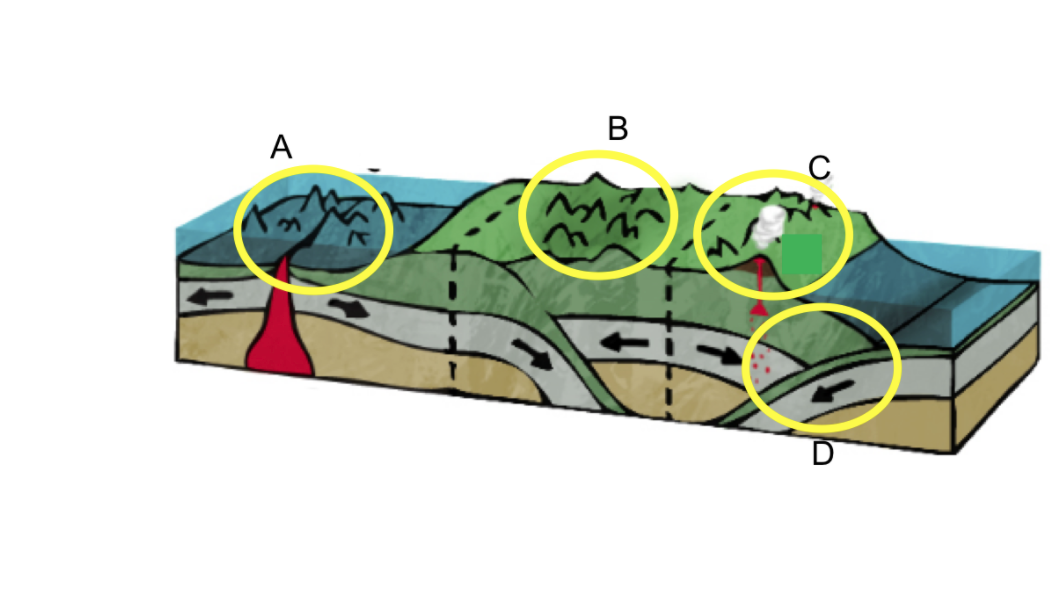
Where are two ocean plates diverging?
A
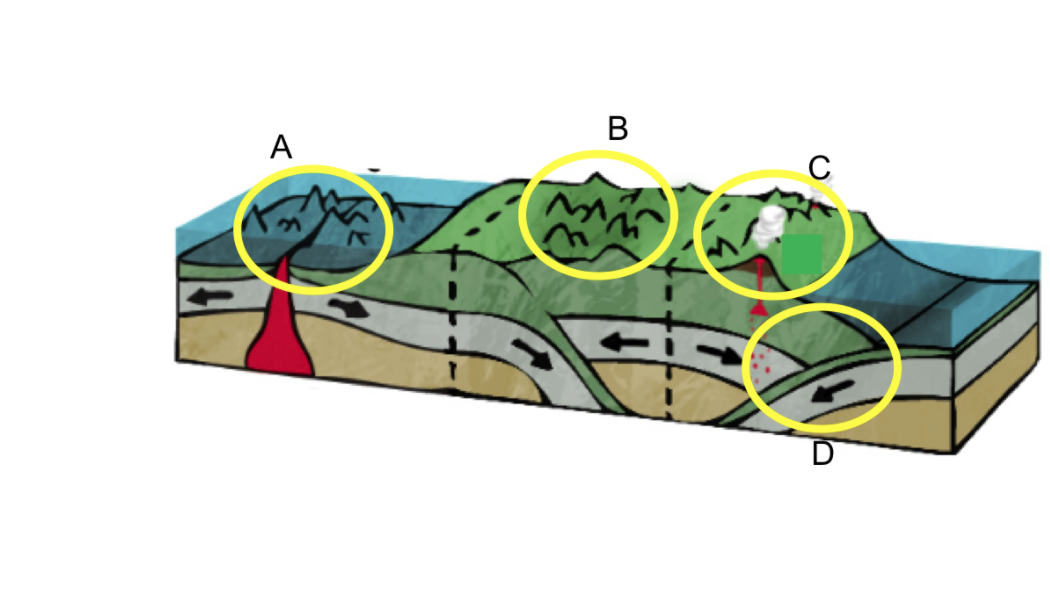
Where is new crust being created?
A

Where are two continental plates converging?
B
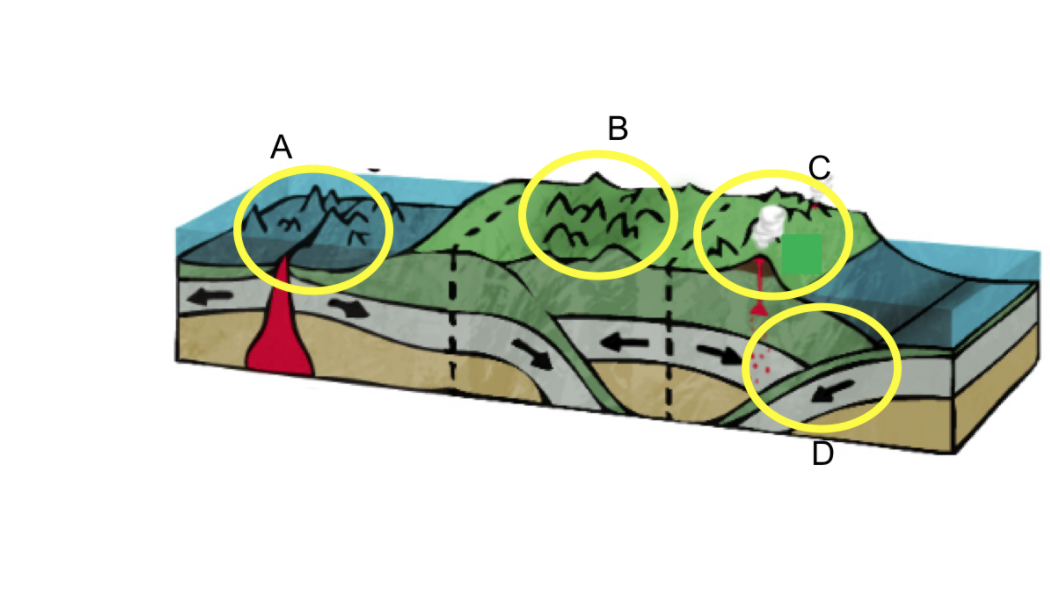
Where is crust being destroyed?
D
Upon which layer of the earth do the plates rest and move?
mantle
asthenosphere
outer core
lithosphere
asthenosphere
According to Alfred Wegener’s theory of continental drift, how were all of the continents originally arranged?
All continents were in the southern hemisphere.
All continents were located opposite of where they are now.
All continents were part of a large mass of land he called Pangaea.
All continents were in the northern hemisphere near ice-covered Greenland.
All continents were part of a large mass of land he called Pangaea.
In which of the following types of plate boundaries is new crust formed?
ocean-continent convergent boundary
continent-continent convergent boundary
divergent boundary
transform boundary
divergent boundary
Besides the discovery of coal in Greenland, what other evidence did Alfred Wegener have to prove his continental drift theory?
similar fossil records on different continents
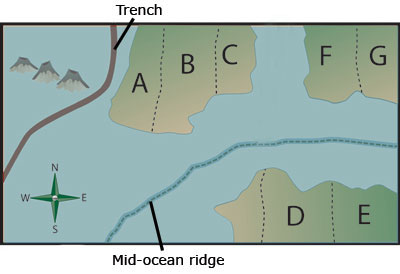
Which type of boundary is not shown on the map?
convergent
collision
divergent
transform
transform
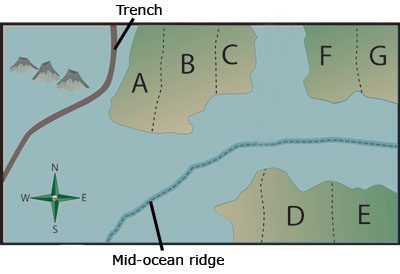
In what direction is the plate with the volcanoes moving?
south
west
north
east
east
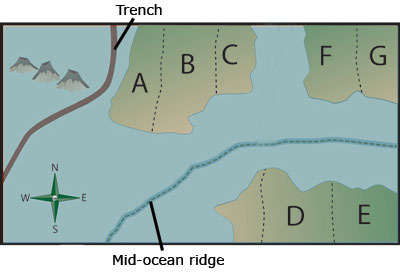
Where would be the safest place to build a bridge?
between B and D
between C and D
between F and C
between G and E
between F and C
Why does the crust have high continents and low ocean basins?
Density differences between continental rock and oceanic rock mean that the continents float higher in the asthenosphere than the oceanic rock.
The asthenosphere is thicker under the continents and thinner under the oceans.
The ocean basins are large impact craters that were formed by the last few planetesimals that hit the earth’s early crust.
Oceanic crust is older than the continental crust, so oceanic crust must be underneath continental crust.
Density differences between continental rock and oceanic rock mean that the continents float higher in the asthenosphere than the oceanic rock.
Why does the crust have high continents and low ocean basins?
Density differences between continental rock and oceanic rock mean that the continents float higher in the asthenosphere than the oceanic rock.
The asthenosphere is thicker under the continents and thinner under the oceans.
The ocean basins are large impact craters that were formed by the last few planetesimals that hit the earth’s early crust.
Oceanic crust is older than the continental crust, so oceanic crust must be underneath continental crust.
Density differences between continental rock and oceanic rock mean that the continents float higher in the asthenosphere than the oceanic rock.
The Himalayan mountain range is being formed by the convergence of which two tectonic plates?
The Eurasian and Indian Plates
the North American and Pacific Plates
the Antarctic and South American Plates
the Eurasian and African Plates
the Eurasian and Indian Plates
The earth developed a layered structure because of
changes in chemical/mineral composition
changes in the density of the internal material
changes in the physical state (solid liquid) of the material
all of these factors
all of these factors
Which of the following best explains the formation of the Japanese Islands?
The islands are the result of a rift in the Eurasian plate.
The islands are the result of a divergent boundary between the Pacific and Eurasian Plates.
The islands are in the middle of the Eurasian Plate and were formed like Hawaii—a result of hot spots.
The islands are the result of a convergent boundary between the Pacific and the Eurasian Plates.
The islands are the result of a convergent boundary between the Pacific and the Eurasian Plates.
Why didn’t scientists believe Alfred Wegener’s theory of continental drift?
The fossil record of different continents did not support Wegener’s theory
Wegener had a reputation for exaggerating information
Wegener had no explanation for what made the continents drift (or move)
The rock and mineral patterns of different continents didn’t support Wegener’s theory
Wegener had no explanation for what made the continents drift (or move)Why does the ocean plate always subduct when it converges with a continent plate?
Why does the ocean plate always subduct when it converges with a continent plate?
because the ocean crust is magnetically pulled under the continent
because the ocean crust is older and ready to be subducted
because the ocean crust is already lower than the continent
because the ocean crust is heavier than continent crust
because the ocean crust is heavier than continent crust
How would you explain the formation of the Hawaiian Islands in the middle of the Pacific Plate?
The Pacific Plate is actually two plates converging together, creating mountains, and the Hawaiian Islands are actually the tops of these mountains.
The Pacific Plate is actually two plates that are diverging, creating a tall ridge, and the Hawaiian Islands are the highest parts of this ridge.
The Hawaiian Islands are the tops of volcanic mountains formed by hot spots under the Pacific plate; as the plate moves, the hot spots create new islands.
The Hawaiian Islands are the last bit of land left after the separation of the South American Plate and the Australian Plate—they will eventually disappear.
The Hawaiian Islands are the tops of volcanic mountains formed by hot spots under the Pacific plate; as the plate moves, the hot spots create new islands.
How do the magnetic patterns on the seafloor support the theory of tectonic plates?
The magnetic patterns prove that the seafloor is old, which is what the plate tectonic theory suggests.
The magnetic patterns prove that the seafloor does not move; only the continents do.
The magnetic patterns on each side of the ocean ridge are symmetrical, which proves that the seafloor is spreading.
The magnetic patterns are formed by earthquakes, which the plate tectonic theory says occur in oceans.
The magnetic patterns on each side of the ocean ridge are symmetrical, which proves that the seafloor is spreading.
Which layer of the earth is not matched with its correct physical state?
crust—solid
asthenosphere—plastic-like
outer core—solid
inner core—solid
outer core—solid
How do volcano and earthquake patterns support the idea of plate tectonic theory?
They are usually found near the borders of plates, which is where plates slide against each other and create stress in the crust.
Most are found on larger continents, and according to the theory, larger continents are still in the process of breaking up.
They are usually found in the center of plates, which is where plates are coming apart and experiencing a lot of stress.
They are usually found on land, which is where plates are coming apart and experiencing a lot of stress.
They are usually found near the borders of plates, which is where plates slide against each other and create stress in the crust.
The state of balance between the thickness of the crust and the depth at which it floats on the asthenosphere is called
stress
strain
shearing
isostasy
isostasy
In which direction is the continent of North America moving?
toward the Pacific Ocean
toward the Atlantic Ocean
toward South America
toward Europe
toward the Pacific Ocean
In which of the following types of plate boundaries is the crust neither created nor destroyed?
ocean-continent convergent boundary
transform boundary
continent-continent convergent boundary
ocean-ocean convergent boundary
transform boundary

Africa is famous for its gold mines. According to evidence that supports the theory of plate tectonics, where would be the best place to look for similar deposits of gold?
A
B
C
D
B
Which mountain range is being created by the convergence of the Nazca and South American plate?
Ural
Rocky Mountain
Andes
Appalachian
Andes
Why are mountain ranges created where two continental plates converge?
Neither plate is subducted; instead, both are lifted up forming a mountain range.
One plate is subducted—pushing the crust of the other plate up.
One plate is subducted, but its crust remains to form a mountain range.
Both plates are subducted—forcing the land up around them.
Neither plate is subducted; instead, both are lifted up forming a mountain range.
Why would the discovery of coal in Greenland be evidence for Alfred Wegener’s theory of continental drift?
Coal is normally found in cold climates; Greenland is not cold enough.
Coal is found in places where jungles used to be; Greenland must have been closer to the equator where jungles are common.
Coal is only found in Antarctica; Antarctica and Greenland must have been connected in the past.
Coal is only found in North America; Greenland and North America must have been connected in the past.
Coal is found in places where jungles used to be; Greenland must have been closer to the equator where jungles are common.
What geologic feature is created when an ocean plate converges with another ocean plate or a continent plate?
rift
trench
mountain range
high plateau
trench
The Caribbean plate is merging with which other plate to form the Caribbean Islands?
the Antarctic Plate
the Eurasian Plate
the North American Plate
the Pacific Plate
the North American Plate
The North American and Eurasian plates are diverging. What physical evidence proves this?
the Appalachian Mountains
the mid-Atlantic ridge
The island of Great Britain
the Rocky Mountains
the mid-Atlantic ridge
Which sphere is not correctly matched?
atmosphere—all the gases of the earth
hydrosphere—the earth’s water
lithosphere—the earth’s solid rock/crust
asthenosphere—all the molten rock inside the earth
asthenosphere—all the molten rock inside the earth
When an ocean plate and a continent plate converge, which plate subducts?
the continent plate
neither plate subducts
both plates subduct
the ocean plate
the ocean plate
In which of the following types of plate boundaries are continental mountain ranges created?
ocean-ocean convergent boundary
divergent boundary
continent-continent convergent boundary
transform boundary
continent-continent convergent boundary
Which of the following best describes what happens at a divergent plate boundary?
The plates smash together and create mountains because neither plate is subducted.
The plates move together and a trench is formed where one plate subducts.
The plates separate from each other creating new seas or lakes.
The plates separate from each other creating new crust in the process.
The plates separate from each other creating new crust in the process.